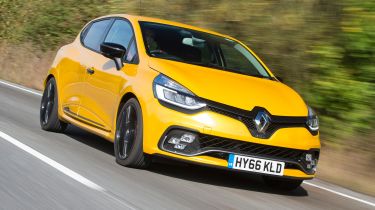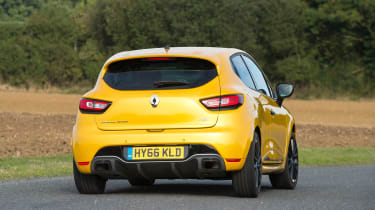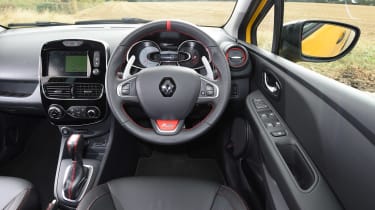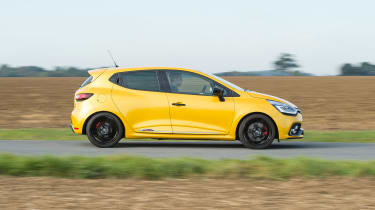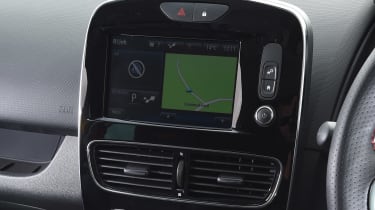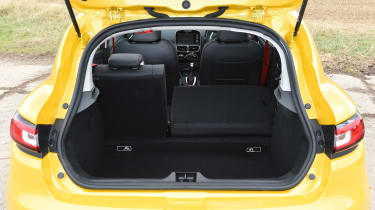Renault Clio RS review
Renault has taken its latest Clio RS hot hatch in a different direction, with a turbo engine, auto box and five-door body

The Renault Clio RS is a hot hatch based on the French firm's Ford Fiesta rival. It first arrived in 2013, ditching the old car's naturally aspirated 2.0-litre engine and sweet-shifting manual gearbox in favour of a 1.6 turbo and DCT dual-clutch auto. It'd be fair to suggest the purists weren't best pleased; by satisfying emissions regulations, Renault diluted much of the Clio's fizzing character and fun-to-drive ethos.
Like the standard Renault Clio, every car gets five doors and a relatively practical cabin. With 197bhp, the standard car goes punch for punch with competitor cars like the Peugeot 208 GTi and Ford Fiesta ST. It'll do 0-62mph in 6.7 seconds and hit 143mph flat out. There's also a Trophy 220 version, which adds an additional 20bhp, 18-inch alloy wheels and lowered suspension – shaving one tenth of a second from the car's 0-62mph time.
Updates brought about in late 2016 mirrored the standard car's mild facelift, with revised lights, new bumpers and special four-LED chequered flag-style DRLs. Those hoping for a manual option were left disappointed, however – as the Clio RS remains auto only.
Renault has a reputation for building lively, effervescent hot hatchbacks that are great to drive, so its current Clio RS represented a departure from the familiar recipe when it hit the market in 2013.
Used - available now

2023 Land Rover
Range Rover Evoque
21,916 milesAutomaticPetrol1.5L
Cash £28,500
2021 Tesla
Model 3
30,193 milesAutomaticElectric
Cash £18,800
2023 Tesla
Model 3
55,994 milesAutomaticElectric
Cash £18,000
2023 Mercedes
CLA
36,008 milesAutomaticDiesel2.0L
Cash £21,200That’s because Renaultsport focused on emissions, cutting the Clio’s engine capacity and adding a turbo, while also opting for a dual-clutch auto gearbox. The latest Clio RS endured a tough start to life, in fact, losing out to the Ford Fiesta ST and Peugeot 208 GTi on its review debut.
Both rivals had the edge as they were cheaper and more fun to drive. But the dinky Renault hot-hatch, with its hi-tech twin-clutch gearbox and turbocharged engine, the new Renault Clio RS is a more grown-up package than its hardcore predecessor. Plus, the roomy cabin and five-door layout make it a practical everyday proposition. It also boasts head-turning looks and an equally stylish interior.
Engines, performance and drive
The Renault Clio RS shares its 1.6-litre turbo engine with the Nissan Juke Nismo RS. With 197bhp, the standard model feels willing and urgent low-down, but the Clio’s power delivery feels strangled higher up the rev range. It’s not helped by the whooshing exhaust note or the sluggish gearbox.
Pull the ‘up’ paddle and the Clio pauses before engaging the next gear – it’s faster in Race mode, but the shift times still aren’t that quick. A long throw to the paddle’s action means you’re never quite sure if your request for another ratio has registered, either.
Despite this, the RS will sprint from 0-60mph in 6.9 seconds thanks to Renault’s launch control system, which manages engine revs for you to make the best getaway possible. It’s explosive off the line, but the anodyne engine loses out when it comes to in-gear acceleration.
Unlike lesser Clios, the RS allows you to fully disengage the stability control to explore the tuned chassis’ capability on track. There's a Trophy model, too, which adds lower springs, bigger wheels and an additional 20bhp. The result is plenty of grip to lean on in quick corners, although if you do push past the limit, the Clio isn’t as progressive or communicative as, say, a Ford Fiesta ST. The Clio Trophy gets the same DCT dual-clutch box.
Instead, the Renault responds better to a neat and tidy driving style, preferring you to place the car accurately with the well weighted steering. It’s an impressive performer, yet it can’t match the Fiesta ST for composure on the track or road. The ride strikes a good balance between control and comfort for a sporty hatchback, but big potholes do send thumps and rattles through the car’s structure.
Engines
There is only one engine option in the Clio RS, though buyers get a choice of two power outputs. The 1.6-litre turbo unit is linked to a dual-clutch automatic gearbox. No manual is available.
The standard car gets 197bhp and 260Nm of torque, while the Clio Trophy boosts those numbers to 217bhp and 280Nm respectively. Opting for the more expensive Trophy car shaves a tenth of a second from the car's 0-62mph time.
MPG, CO2 and Running Costs
In our experience, the Clio isn't the most economical hot hatchback. In mixed driving conditions, our RS test car returned 27.0mpg – some way short of the claimed 47.9mpg that Renault publicises. Despite using a supposedly less economical manual gearbox, Peugeot reckons its 208 GTi will do 52.3mpg.
Still, emissions of 133g/km mean the Clio is a relatively good value company car – falling into the 25 per cent Benefit in Kind (BiK) tax band.
Insurance groups
The 'entry-level' Renaultsport Clio is rated in insurance group 27, while the Trophy model is group 28. That compares favourably with rivals like the Peugeot 208 GTi, which sits in group 33.
Depreciation
Despite complaints about the Clio RS's dual-clutch gearbox, every version is predicted to hold on to at least 46 per cent of its value after three years and 60,000 miles. Due to its lower list price, the standard version will lose you less money, but there really isn't much in it. That's much better than its closest rival, the Peugeot 208 GTi, which is expected to retain closer to 31 per cent of its value.
Interior, design and technology
There’s no mistaking the Renaultsport Clio for one of its lesser stablemates. There are performance-focused design touches everywhere, from the gaping twin tailpipes and rear diffuser to the distinctive front end, featuring an F1-style silver front blade specific to the RS. There are bulging wheelarches, plus you can spec optional 18-inch gloss black alloys (17-inches come as standard) and £1,300 Liquid Yellow metallic paint.
From all angles the Renault looks every inch the aggressive hot hatch, with a boot spoiler, deep front bumper and RS badging transforming the curvy, regular Clio into something much more hardcore. The Trophy version is more aggressive still, with bigger wheels and lowered suspension.
Inside, Renault has been less adventurous with the styling changes, however. The RS gets a pair of more supportive sports seats, grey-faced RS dials and some red flashes on the gearlever, doors and air vents. Other than that, though, much of the cabin is carried over from the rest of the Clio range. But that’s no bad thing, as apart from some budget plastics, the Clio’s interior is functional and loaded with equipment.
Sat-nav, stereo and infotainment
Everything is controlled from the central seven-inch touchscreen tablet, with sat-nav, Bluetooth, cruise control and USB connectivity all fitted as standard. Large icons and clear graphics mean the infotainment system is intuitive to use.
A Renaultsport Monitor can be specced, which gives real-time performance data on the colour screen. You can download your fastest laps from your favourite race tracks, and view different engine and gearbox parameters. It’s a touch gimmicky, but is aimed at the younger audience Renault is trying to attract with its raciest Clio.
Practicality, comfort and boot space
Making a five-door look like a sportier three-door hatch is a clever trick. The Renault Clio’s designers have neatly hidden the rear door handles with a rising beltline, keeping a rakish profile, but adding practicality.
It means access to the rear is easy, and the RS’s width at the back means the interior is roomy. The boot is a good size, too. At 300 litres, it’s a deep, usable, square shape, and the seats fold easily so it’s simple to enlarge the load bay to the maximum 1,146 litres. When stowed, the rear seats sit almost flat, too.
There are drawbacks, however, and storage space is one of them. It’s fairly limited – for example, the glovebox is tiny as right-hand-drive Clios have to accommodate the fusebox.
Size
At just over 4m long and 1.73m wide, the Clio RS is a little longer, but a little narrower than a Peugeot 208 GTi. Still, like any car of this type, it's easy to drive around town and simple to park thanks to its compact supermini-sized dimensions.
Leg room, head room & passenger space
It's only available as a five-door, which automatically makes the Clio RS a more practical car than the Peugeot 208 GTi. The low roofline, small side windows and high-mounted rear seats ensure it still feels quite cramped in the back, however.
Boot
Despite feeling its age, the Clio RS is still one of the more practical fast small cars on sale. With a 300-litre boot, it offers 15 litres more than the Peugeot 208 GTi, while folding the seats it's bigger still – 1,146 litres plays the Pug's 1,076 litres.
Reliability and Safety
French manufacturers have traditionally been criticised for poor reliability and flimsy build quality, but Renault has dramatically improved in these areas over recent years.
However, in our 2017 Driver Power survey, Renault could only manage a disappointing 22nd place out of 27 manufacturers in the overall rundown. The Clio finished 70th out of 75 in the new car list, too, with particularly poor scores for reliability, ride and handling, and engine and gearbox.
Renault’s fourth-generation Clio boasts plenty of safety kit, however, including six airbags and a tyre pressure monitoring system that helped it score a maximum five-star rating in Euro NCAP’s crash tests. However, it isn’t available with any autonomous braking safety aids.
Warranty
Renault offers every Clio RS with a four-year, 100,000-mile warranty – provided under the brand's 4+ care scheme. The package also includes breakdown cover.
In addition, the firm offers fixed price service items. The cambelt, for example, costs from £549, while front brake pads start at £129.
Servicing
The great thing about owning a hot hatch, is that quite often they require no more maintainance than the standard petrol or diesel version. The Clio RS will need servicing annually or every 12,500 miles, whichever comes first.
